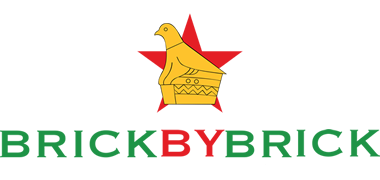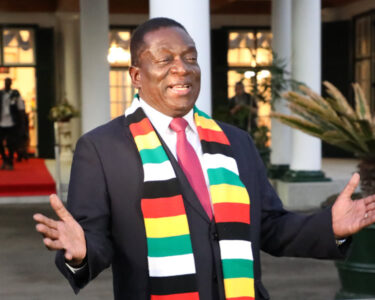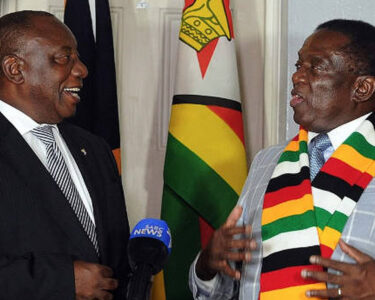If you are one of those people who never take time to travel across Zimbabwe to see what is happening in the countryside, you will never know that devolution jumped from the pages of government documents and is now being felt in some of the remotest parts of the country. And if you are one of those who spend their time twiddling fingers on social media, you will think it’s not newsworthy that a clinic, school or road has been constructed in Chirumhanzu, Tsholotsho or Chiendambuya. It’s all very well, but that won’t stop the train!
Since December 2017, when President Emmerson Dambudzo Mnangagwa came into power, the Second Republic has upped the tempo in its quest to implement the devolution agenda. Against the odds and with doubting Thomases throwing all sorts of spanners into the works, government has not taken its foot off the pedal as it seeks to bring services closer to the people, enhance local democracy through community participation in identifying priority projects, improve allocative efficiency in all tiers of government (national, provincial and metropolitan councils and local authorities) and transform the lives of people living in previously marginalised areas.
Devolution has become the buzzword in Zimbabwe and, as you must know by now, wherever and whenever there is a buzz that is contributing to the country’s development thrust, the Brick by Brick magazine bends over backwards to bring you the full story behind the buzz. Seeing that the devolution buzz is showing no signs of abating, the editors decided to make devolution the main theme of the current edition of your favourite developmental magazine.
Tucked within the pages of this magazine are interviews with the architects of the devolution concept in Zimbabwe. To get the ball rolling was none other than the driver of the devolution agenda, President Mnangagwa, who shared his views on the concept and expressed satisfaction at the pace at which it is being implemented. Then we had a long chat with the facilitator of the devolution agenda, the Minister of Local Government and Public Works, July Moyo, who spoke passionately about the philosophy behind the concept and the progress made so far from the central government’s perspective.
In true brick-by-brick fashion, we engaged all the country’s provincial and local authorities to learn about their experiences in their role as devolution’s foot soldiers. They did not disappoint. Without prompting, they gave blow-by-blow accounts of how devolution is transforming the lives of people in previously marginalised areas. More importantly, they highlighted the challenges they are facing which they hope will be swiftly attended to by the central government. What was really fascinating and inspiring was the zeal these foot soldiers showed in making devolution work.
Then, of course, we went on the ground to see devolution at work. Slowly, and tucked away from the prying eyes of social media, Zimbabwe is going through a revolution in terms of uplifting the lives of men, women and children in remote parts of the country. I have said this in previous editions of the Brick by Brick magazine; and I will say it again: Zimbabwe will soon surprise the world because President Mnangagwa is up to something big. Watch this space!
Cheers to Triple B!
Dear readers, before plunging into devolution matters, allow me to propose a toast! Since its inaugural issue in November 2022, Brick by Brick magazine has caused a stir among Zimbabweans across the board – in cities, villages, schools, colleges, universities, embassies, national, regional and international conferences.
Known in some circles as Triple B or simply BBB, the magazine has even attracted presidential and royal interest from across the borders. There are reports that on seeing the Brick by Brick magazine, quite a number of African leaders, not to mention corporate executives, have summoned their communication teams and ordered them to take a leaf from its exemplary approach to development issues.
Dear readers, allow me to give a toast because, for the first time in Zimbabwe, we have a magazine that has put paid to the myth that developmental news is boring. More importantly, we have proved beyond any reasonable doubt that the printed word, as a medium of communication, is very much alive and kicking contrary to the doomsayers who have been predicting its death over the years.
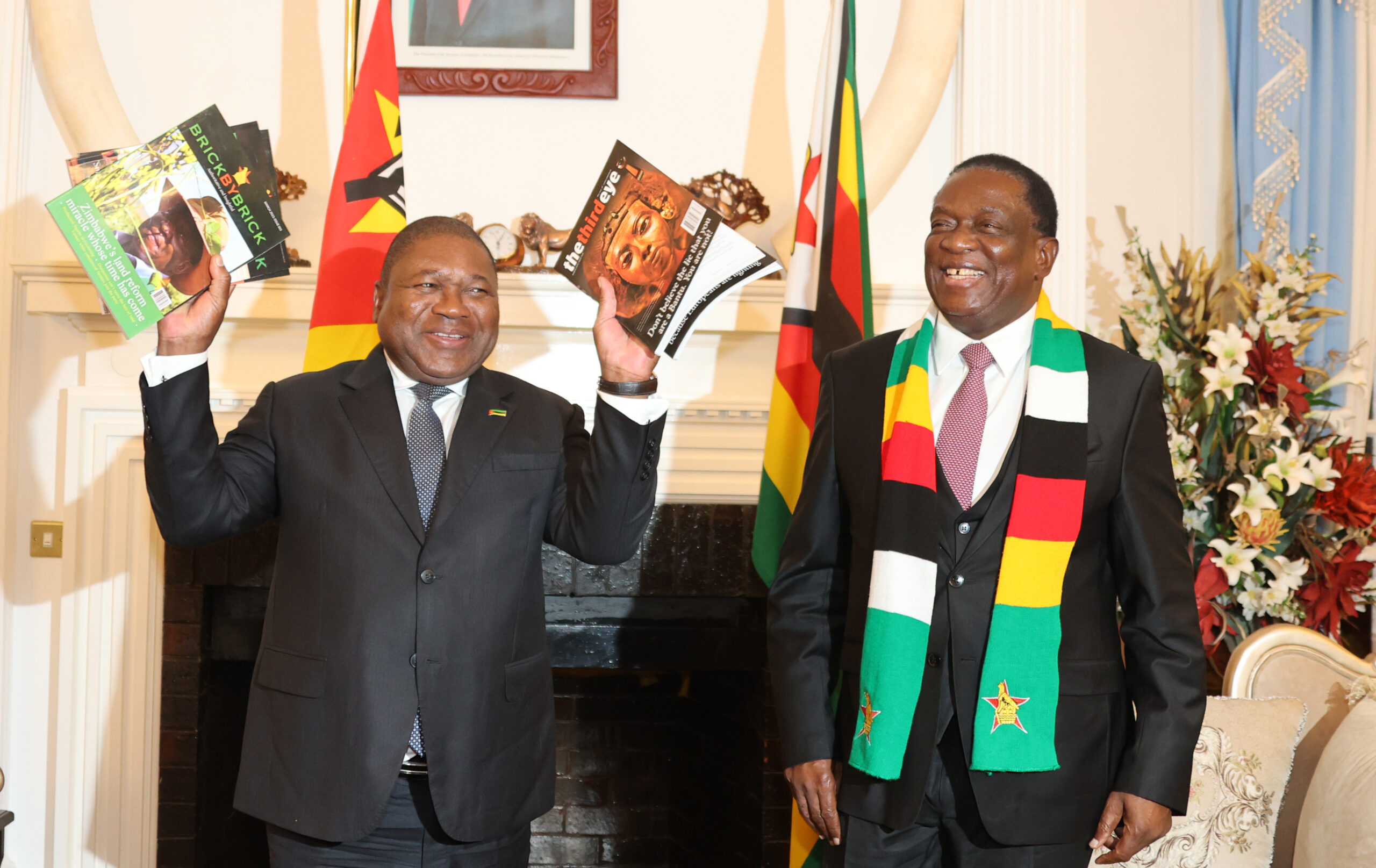
Now, wherever you are, dear readers, raise your glasses; or whatever you see fit, to the Brick by Brick magazine! The editorial team will not get tired of criss-crossing the country to give you comprehensive, authoritative and insightful developmental stories. Zimbabwe is undergoing a quiet revolution in terms of development. Africa’s true economic giant has woken up! You won’t find the news on social media platforms. It’s the kind of stuff that is synonymous with patriotic journalism and at Triple B, we practise it without apology!
Gathering news from the people and taking news to the people is what we do best! Kudos to Triple B! Cheers to a magazine that makes bricks look like diamonds! A magazine that makes development sound so captivating! A magazine driven by conviction! Cheers to Triple B!
Of course, brickbats are likely to fly my way from those who accuse me of blowing my own trumpet. It comes with the territory, but then isn’t it they say, “bragging is not an attractive trait, but let’s be honest – a man who catches a big fish doesn’t go home through an alley”. Some say, “it’s not bragging if it’s true”, while others add: “It’s not bragging if you can back it up!” Try us if you think we will not measure up. Once again cheers to BBB!
Now that the toast is out of the way, it’s time to get down to the business of the day – DEVOLUTION, in capital letters, of course.
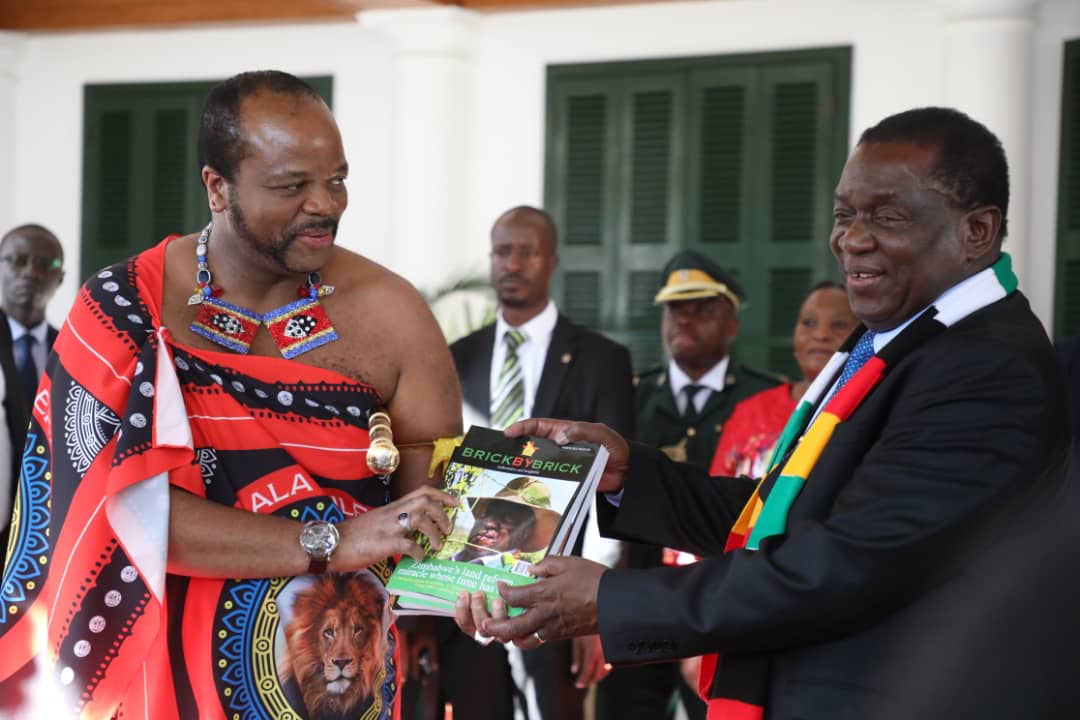
Over the past 5 years, the Second Republic has been pushing the devolution agenda like a sportsperson on steroids, leaving many wondering as to the source behind this sudden interest in the concept. The prophets of doom have been praying — and hoping — that the Second Republic will soon run out of steam and abandon devolution. But if only they knew what transpired during President Mnangagwa’s first Cabinet meeting in December 2017, they would know that the devolution train has no reverse or parking gears. It’s forward forever, backwards never!
While millions of Zimbabweans were preoccupied on the political developments unfolding before their eyes from November to December 2017, the man who was to later take over the reins of the country, President Mnangagwa, already had his eyes firmly fixed on the ball. The political euphoria at the time did not distract him from looking ahead like the veteran lawyer that he is.
In an interview with the Brick by Brick magazine published elsewhere in this magazine, the Minister of Local Government and Public Works, July Moyo, revealed that during his very first Cabinet meeting, President Mnangagwa made it abundantly clear that devolution was on top of the Second Republic’s development agenda. According to Minister Moyo, President Mnangagwa practically ordered the then-Minister of Finance, Patrick Chinamasa, to immediately disburse devolution funds to provinces and local authorities. But he was advised that this was no longer possible as the budget process had already been concluded.
According to Minister Moyo, President Mnangagwa used the Cabinet meeting to set the tone on how seriously and urgently he wanted devolution to be implemented under his watch. Since then, the government has gone all out to ensure that no one and no place is left behind in terms of developing the country through devolution.
For those not in the picture, let me point out that devolution is not a creation of the Second Republic. It is enshrined in Chapter 14 of the May 2013 Constitution. The chapter devotes the entire Section 264 to the devolution of political power, decision-making, distribution of resources and governance to the 3 tiers of government, i.e. the central government, provincial and metropolitan councils and local authorities.
The Constitution is also very clear when it comes to the allocation of devolution funds, known technically as Inter-Governmental Fiscal Transfers (IGFTs). Section 301 (3) stipulates that at least 5% of the national revenues raised in any financial year should be allocated to provinces and local authorities. To buttress the Constitution, the Urban Councils Act, the Rural District Councils Act and the Provincial Councils and Administration Act spell out devolution powers in finer detail.
In a paper titled Devolution of power in Zimbabwe’s new constitutional order: Opportunities and potential constraints, published in the journal, The Law, Democracy and Development, Volume 18, in 2014, Philani Moyo and Cornelias Ncube unpacked Zimbabwe’s statutory objectives for the devolution of governmental powers and responsibilities as follows:
“(a) to give powers of local governance to the people and enhance their participation in the exercise of the powers of the state and in making decisions affecting them; (b) to promote democratic, effective, transparent, accountable and coherent government of Zimbabwe as a whole; (c) to preserve and foster the peace, national unity and indivisibility of Zimbabwe; (d) to recognise the right of communities to manage their own affairs and to further their development; (e) to ensure the equitable sharing of local and national resources; (f) to transfer responsibilities and resources from the national government in order to establish a sound financial base for each provincial and metropolitan council and local authority.
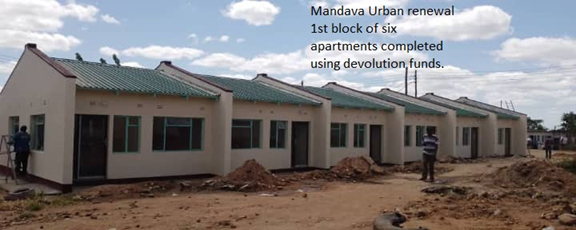
renewal programme has been completed using devolution funds
“In accordance with the above devolution constitutional vision, political power, policymaking decisions, resource raising and distribution, as well as administrative and governance responsibilities are meant to be devolved through 3 tiers of government. These include: (1) the national government; (2) provincial and metropolitan councils; and (3) local authorities (which include urban councils and rural councils).
“The national government is composed of national ministers who constitute the Cabinet (the executive arm of government). These Cabinet ministers are directly elected Members of the National Assembly (MPs), senators or non-constituency ministers appointed by the President in terms of the new Constitution. The second tier of government — provincial and metropolitan councils — is composed of directly elected and proportional representation public representatives elected using constitutional provisions contained in Chapter 14 (2:268) (for provincial councils) and Chapter 14 (2:269) (for metropolitan councils).
“The third (and by no means the least) tier of government is that of the local authorities. These are the grassroots level urban councils and rural councils. These councils are composed of ward councillors directly elected using constitutional provisions contained in Chapter 14 (3:277) read together with Chapter 14 (3:274) (for urban councils) and Chapter 14 (3:275) (for rural councils).
“In broad terms, rural councils are expected to represent and manage the affairs of people in rural areas within districts into which Zimbabwe’s provinces are divided, while urban councils do the same in urban areas. The small size of wards from which councillors (who make up the council) are drawn enables councillors to be in continuous close contact with their constituents. This potentially provides an avenue for local citizens to access their political representatives thereby enabling their voice to be heard in decision-making that affects their local service delivery and local development.”
The lethargy from 2013
Clearly, the Constitution is very clear on devolution. However, from 2013 when the Constitution was adopted until 2017, very little or next to nothing happened on the ground. This led to suspicions that the government was reluctant to improve the lives of people living in marginalised areas of the country. Understandably, the government was accused of lacking the political will to implement devolution.
Said Jean Mukoyi in an article titled Chapter 14 of the Constitution and implementation of devolution in Zimbabwe, published in the International Journal of Scientific and Research Publications, Volume 10, Issue No. 11, of November 2020:
“With the enactment of the 2013 Constitution, it was hoped that through local governments, public participation, peace and unity would be enhanced as well as an improvement in the equitable distribution of resources. However, the events on the ground show that since 2013, devolution is still a fallacy as evidenced by the underdevelopment and marginalisation of resource-rich provinces in Zimbabwe. The paper notes that the delays in implementing devolution can be attributed to the non-alignment of local governance legislative pieces to the Constitution and the lack of political will by the central government to devolve authority and resources to local governments.”
Mukoyi was correct, but only to an extent. Her research findings were correct when confined to the 5 years from 2013 until late 2017. Developments on the ground from November 2017 up to date refute her conclusions because the Second Republic is making significant strides in devolving powers to provincial and local authorities as dictated by the Constitution.
The evidence is there in terms of devolution funds allocated and disbursed. There is evidence galore in terms of tangible projects on the ground that are changing people’s lives for the better. Provincial and local authorities are now capacitated and legally empowered to make decisions. Furthermore, members of local communities are now empowered to identify projects to be prioritised under devolution. This is not hearsay. It is backed by solid facts and statistics.
Of course, there are still some teething problems that need to be addressed because devolution was, and is, never going to be an event, considering that Zimbabwe operating under the dark clouds of a punitive sanctions embargo. In such a situation, devolution can be a long, arduous and sometimes even painful process, but the Second Republic is marching relentlessly on to realise its fruits.
What is devolution anyway?
Part of the answer to this question is contained in a paper titled Zimbabwe’s transition to a devolved system of government: Critical factors for success. Writing in the April 2022 edition of Africa’s Public Service Delivery and Performance Review, Tawanda Nyikadzino and Shikha Vyas Doorgapersad posited that devolution “involves the sharing of the management of public affairs of a country among the different tiers of government in such a way that the lower tiers are granted reasonable scope to raise funds and use resources in the provision of a range of services that contribute towards the enhancement of the welfare of the residents”.
This brought them to the inescapable conclusion that “. . . the devolution of governmental powers and authority ensures the recognition of local governments as legitimate and autonomous institutions and strengthens their capacity as problem-solving grassroots governments”.
On the other hand, Philani Moyo and Cornelias Ncube had no doubt in their minds that: “Political decentralisation (specifically, devolution of power) aims to statutorily transfer some political power, local policymaking and administrative responsibilities and resources from central government to citizens and/or their democratically elected regional, provincial or local authorities.
“One of its main aims is to capacitate sub-national tiers of government to respond to problems of a purely local nature without waiting for policy instructions and directives from the central government . . . it is clear that power and space are at the heart of devolution since it is anchored in wide dispersal of authority to local authorities.”
Devolution can’t be a stroll in the park
While the theoretical definition of devolution appears so easy to grasp, developments in the country’s 10 provinces show that devolution is not a stroll in the park. However, Zimbabweans need not worry because the teething challenges being experienced by the provincial and local authorities across the country are not peculiar to Zimbabwe.
According to Nyikadzino and Doorgapersad, the most daunting challenge facing devolution is a lack of capacity and personnel at sub-national government level to exercise responsibility for service delivery. This was because of the additional policy formulation and implementation responsibilities, common in the initial stages, devolution can amplify local capacity constraints.
“Therefore, the effective and sustainable implementation of devolution in Zimbabwe will only be guaranteed if the requisite capacity to exercise devolved powers and responsibilities is prioritised and developed.
“Devolution transfers a significant portion of central government functions to lower levels and should, therefore, be accompanied by relevant capacity-enhancement initiatives . . . managing and sustaining decentralised governance for effective delivery of services require adequate capacity in institutions, networks, organisational structures, facilities and equipment, human resources, as well as data and information . . . devolution requires concerted capacity building efforts by the national government at the very outset.
“Devolution should come with extensive capacity strengthening and training of political and administrative personnel at both the national and sub-national government levels. Local authorities should be supported by other spheres of government in the development of their administrative, technical, and managerial capacities, and of their structures, which must be responsive, transparent, and accountable . . .
“Sub-national governments should have the required human, financial, and technological resources to discharge their responsibilities effectively and efficiently . . . There is also a need for training and retraining of local government officials, including elected councillors, so that they can understand and be in a position to deal with devolution,” observed Nyikadzino and Doorgapersad.
The 2 researchers were spot on because when the Brick by Brick magazine asked Minister Moyo about some of the challenges facing the government as it implements devolution, he echoed similar sentiments. Said Minister Moyo: “The biggest challenge has been the understanding of the theory of devolution. There is confusion between 2 types of decentralisation. Decentralisation is the bigger picture. You can decentralise through devolution or you can decentralise through decongestion and delegation. Those 2 are [often] mixed. The theory of devolution is not properly understood.
“The other issue is about the roles that need to be played between central, provincial and local authorities. Central government’s role is to exercise quality control. The power to delegate and still not absolve yourself from the activities because at the end of the day we are serving the same people. What we have devolved as central government, we must follow it up to make sure that it is implemented.
“The third issue is respect of these institutions that we have built through devolution. If they are weak, it’s our responsibility to strengthen them. If they are corrupt, it’s our responsibility to make sure that we eliminate that corruption through the existing systems. When you decentralise, some people say you are also decentralising corruption. We have to fight that.
“Finally, our people must get the benefits of that decentralisation. They should be able to measure that what is being done to us and what is being done to the other people, there is no favouritism. We are being treated equally. [This is what we term] the equalisation of resources.”
“Bring it on!” — the provinces are screaming
After spending the last 9 months travelling extensively across the country’s 10 provinces, I can, without any shadow of doubt, confirm that the implementation of the devolution agenda is in full swing, despite the obvious challenges. The political will is there from central government to devolve powers; and the zeal is there in abundance from the provincial and local authorities to implement devolution. More importantly, members of the community are excited because they now feel that government has been brought to their doorsteps.
In wide-ranging interviews published elsewhere in this magazine, provincial and rural authorities clearly demonstrate how grateful, how relieved and how excited they are that the Second Republic is doing everything possible to devolve powers right down to the grassroots.
“The devolution agenda under the Second Republic has transformed Matabeleland South Province rigorously in multi-faceted ways. A lot of projects have been initiated, implemented and completed, thereby improving the standard of living among the communities.
“The initiative is one of the best ever conceived by the Zimbabwean government in that it addresses the felt needs of the communities. In the past, most major projects were being implemented mainly in big cities like Bulawayo and Harare, leaving out other smaller towns, municipalities and rural areas.
“Devolution has helped to transform lives in Matabeleland South. Clinics have improved access to primary health care and slashed the distance travelled to health centres. Tractors ferried construction materials and other deliveries needed by communities. Refuse trucks collected refuse to designated dump sites. Classroom blocks reduced congestion of pupils in the learning space while new schools reduced walking distances to and from learning institutions.
“In addition, devolution has empowered sub-national tiers of government through participation in decision-making processes on matters that directly affect communities. It has also improved the financial base of local authorities to enable them to undertake projects which were long planned for but could not be completed due to funding constraints. We have also witnessed a vast improvement in the trafficability of roads and access to basic services,” said one of the foot soldiers we spoke to in Matabeleland South Province.
Mashonaland Central Province was singing the same tune: “The devolution agenda has empowered lower tiers of government to participate in development planning, starting from the grassroots levels and feeding into the national plan. Participation flows through the following technical structures, village development committees (VIDCOs), ward development committees (WADCOs), rural district development committees (RDDCs), provincial development committees (PDCs) through to the National Development Committee.
“The devolved structures of government have enhanced accountability to the electorate as well as delivering of efficient public services. The disbursement of devolution funds has resulted in the implementation of projects with high social and economic impact.
“Devolution funds have resulted in the capitalisation of local authorities with earthmoving equipment, vehicles and motorcycles for project supervision purposes, solarisation and computerisation of offices, among others.”
The views expressed above are just a sample of the upbeat mood across the country’s 10 provinces. The provincial and local authorities are full of gratitude to the Second Republic in general and President Mnangagwa in particular for empowering them to serve the people at close quarters. Dear reader, as you flip through the pages of this edition of Brick by Brick magazine, you will discover that, indeed, the devolution plane took off in earnest in 2017 and is now about to get into cruise control.
However, just like Minister Moyo noted, there are still some challenges that need to be addressed before the devolution plane gets to its destination. In an article headlined “Enhancing socio-economic rights in the Mashonaland Central Province of Zimbabwe through fiscal decentralisation: Progress and challenges, published in the Quest Journal of Management and Social Sciences, 3(2) in 2021, Paradzai Munyede, Cosmas Chikwawawa and Delis Mazambani summarised the challenges being faced by government as it continues to roll out devolution across the country as follows:
“The study noted that since the transfer of funds to local authorities started in 2019, significant progress has been achieved in the fulfilment of socio-economic rights. However, local governments were facing challenges such as the unavailability of an administrative manual to guide them in the implementation of fiscal decentralisation, lack of clear funds allocation criteria, untimely and unpredictable distribution of funds, price instability, cumbersome procurement processes and lack of a monitoring and evaluation framework. These challenges were negatively affecting the attainment of the desired goals.”
As a way forward, the researchers made the following recommendations: “Fiscal devolution has already started paying dividends in enhancing the socio-economic rights of communities in the Mashonaland Central Province of Zimbabwe in key sectors such as water and sanitation, education, health care, infrastructure development, governance and administration, and peace and security.
“There is a need to develop an administrative manual for implementing fiscal devolution, timely disbursement of devolution funds, use of virtual meetings in the wake of the Covid-19 pandemic, integration of monitoring and evaluation mechanisms, and capacity building of local government policymakers and administrators.”
Despite the challenges, Minister Moyo remains upbeat that devolution will achieve the desired results. “All things to the best of our ability, following our Constitution and statutes, I see a Zimbabwe [in 5 years] whose growth rate will surpass that of the Asian Tigers. Through devolution, everyone’s potential is being put to use and this is what I think will make this country grow faster. The President’s vision of an upper middle income economy by 2030 is only possible through devolution.”
Obviously, the sceptics will disagree. But I would like to refer them to an African proverb that goes something like this: “Despise not a snail for its slow and struggling movement; it has a destination and with time it shall arrive!”
Indeed, we shall arrive!

